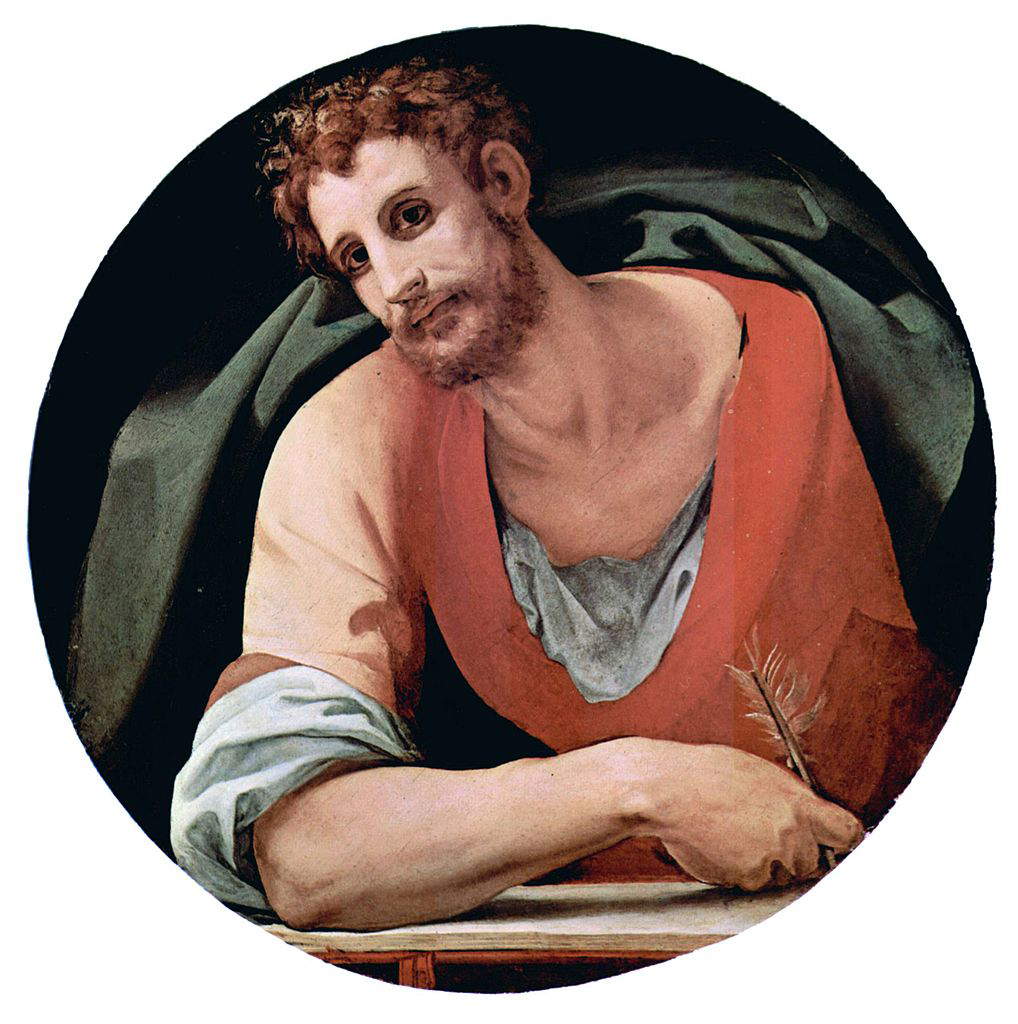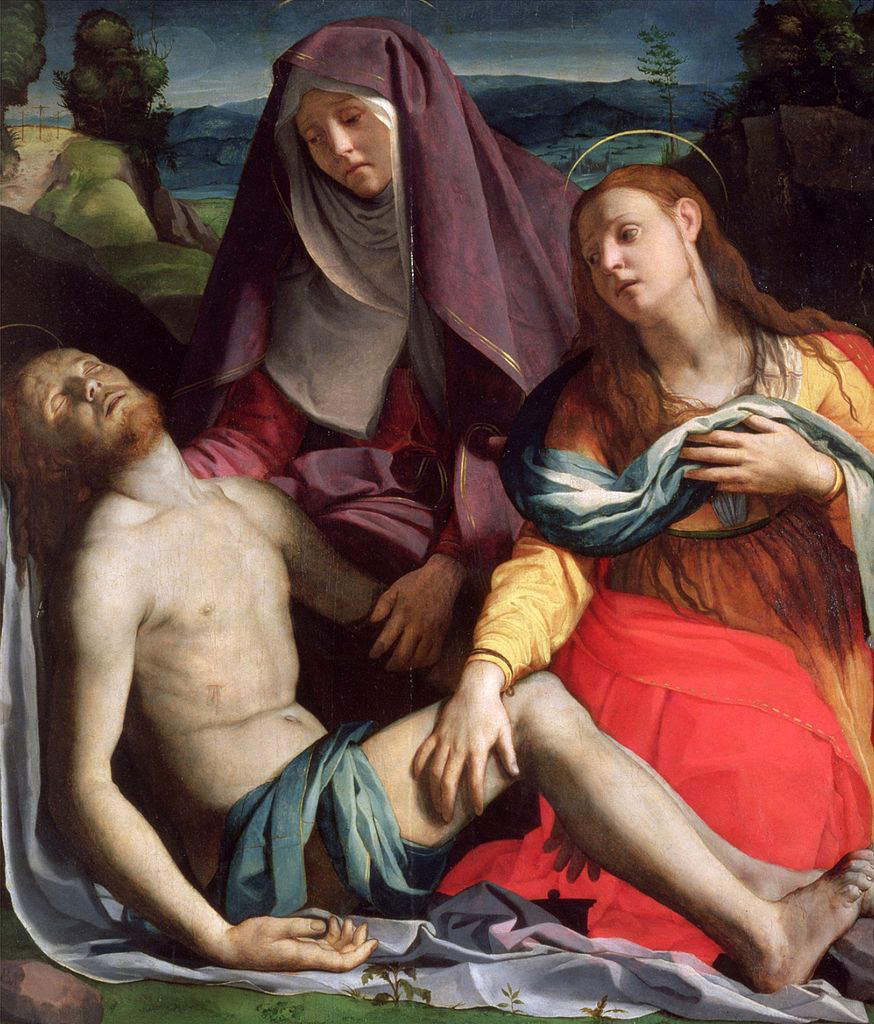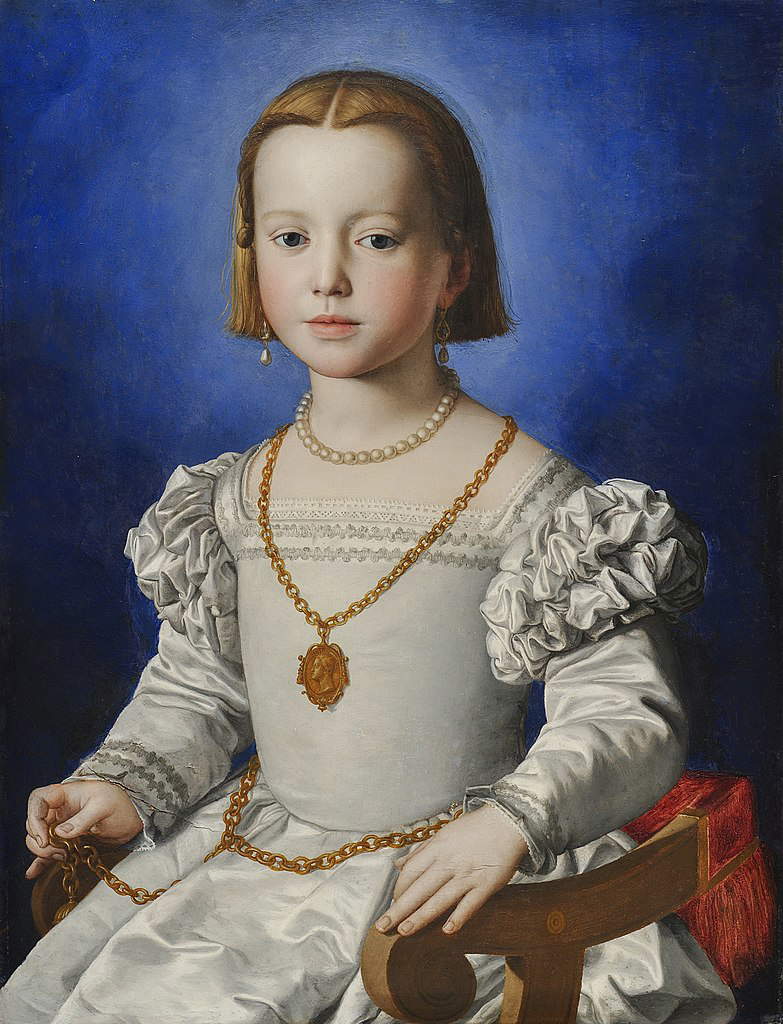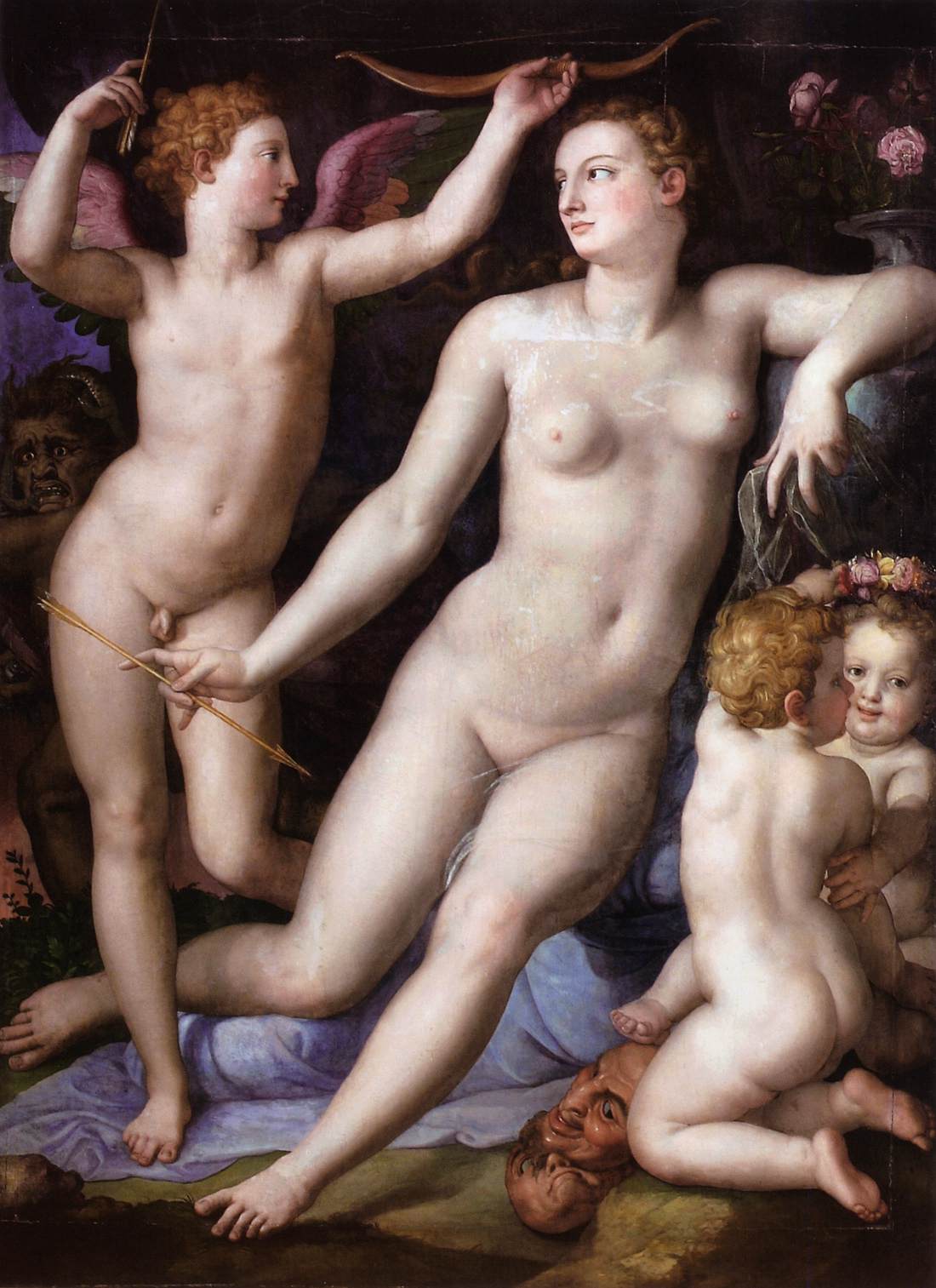Bronzino (Agnolo di Cosimo Tori; Florence, 1503 - 1572), so nicknamed perhaps because of the color of his hair, was one of the greatest exponents of Mannerism, who together with his master, Jacopo Carucci known as Pontormo (Pontorme di Empoli, 1494 - Florence, 1557) contributed to the city of the Medici family’s great artistic season. Bronzino produced paintings with religious themes, allegorical and mythological paintings, as well as splendid and celebrated portraits that gave fame and success to an extraordinary painter, who was also a poet and fine intellectual.
His entire career took place in Florence: in fact, Bronzino was trained in Florence, began painting in Florence, obtained his most prestigious works, achieved his successes, and ended his career. Also in Florence, in the city’s museums, the most substantial core of his works is preserved. Bronzino never moved from Florence except for a brief stay in Pesaro, between 1530 and 1532, when he left the city to move in with the Della Rovere family: in fact, Pesaro was part of the Duchy of Urbino. Pesaro was home to the so-called Villa Imperiale, an important holiday residence of the Della Rovere family, and Bronzino had been called here to participate in the decorations along with another great painter of the time, Dosso Dossi. However except for this brief episode, Bronzino’s career took place entirely in Florence at the court of the Medici, of whom he became the official painter.
The son of a butcher, the artist entered at a very young age the workshop of Raffaellino del Garbo (San Lorenzo a Vigliano, 1466 - Florence, 1524), a refined Tuscan painter active between the fifteenth and sixteenth centuries, who followed the lessons of Filippo Lippi and Ghirlandaio: we have evidence of this apprenticeship also in the second edition of Giorgio Vasari’s Lives. However, the artist soon left the workshop of Raffaellino del Garbo and went to work with Pontormo, who was first his master, then later the two became friends and collaborators. With his stay in Pesaro he then had the opportunity to come into contact with the great artists who worked in Urbino, such as Piero della Francesca and Dosso Dossi himself, but also with artists such as Giovanni Bellini and Titian. The early years of his career, however, are marked by his closeness to Pontormo: the best viaticum for a career that made him one of the most appreciated painters of his time.
 |
| Bronzino, Allegory of the Triumph of Venus (c. 1545; oil on panel, 146 x 116 cm; London, National Gallery) |
Agnolo (Angelo) Tori was born in Florence on November 17, 1503: his father, Cosimo, was a butcher by trade. The nickname “Bronzino” was probably due to the fact that he had blond hair. In the 1910s he completed his training first under Raffaellino del Garbo then together with Pontormo (he would enter his workshop around 1517), with whom he later became good friends. In 1523 he worked with Pontormo on the frescoes of the Certosa del Galluzzo in Florence: this was Bronzino’s first known commission. Also with Pontormo, in 1525 he worked on the church of Santa Felicita in Florence, where he executed the tondi with the evangelists Matthew, Luke and Mark. Around 1529 he painted the Lamentation over the Dead Christ in the Uffizi. In 1530 he stayed in Pesaro where he went to work for the Della Rovere family on the Villa Imperiale decorations along with Dosso Dossi. In 1532 he returned to Florence, from where he would not move again except for short stays. He again helped Pontormo with the frescoes in the Medici villa at Poggio a Caiano. In 1538 he published the burlesque poem Del Pennello, while in 1540, at the age of thirty-seven, he was appointed court painter in Florence by Cosimo I de’ Medici, and around the same year he worked for the powerful Panciatichi family, for whom he executed a number of important works, including the Christ Crucified now preserved in Nice. He became in 1541 a member of the Accademia Fiorentina founded by Cosimo I.
About 1542 the artist executed the celebrated portrait of Bia de’ Medici, while another of his most famous masterpieces, the portrait of Eleonora di Toledo, wife of Duke Cosimo I, with her son Giovanni, dates from 1545. In the same year he was commissioned to decorate Eleanor’s private chapel. Around 1545 he executed theAllegory of the National Gallery in London, probably his most famous masterpiece. Around the same year he painted the portrait of Andrea Doria in the guise of Neptune. He made a brief stay in Rome in 1548 and in the same year was expelled from the Accademia Fiorentina for his irreverent and nonconformist attitudes. He stayed briefly in Pisa in 1550.
In 1557 Pontormo died, and Bronzino was given the task of completing the frescoes begun by his friend in the choir of the basilica of San Lorenzo. In 1558 he began writing the Saltarelli, a series of burlesque compositions. He became a “reformer” of the Accademia del Disegno in 1561, and in 1564 he collaborated on the apparatus for Michelangelo Buonarroti’s funeral. He is again admitted to the Accademia Fiorentina in 1566, eighteen years after his expulsion. In 1568 some of Bronzino’s compositions praising Benvenuto Cellini’s Perseus are published. On June 15, 1572, he was appointed consul of the Accademia del Disegno. On November 23 of the same year he died at the home of Alessandro Allori, his most faithful pupil.
 |
| Bronzino, Saint Mark (1525; oil on panel, diameter 70 cm; Florence, Santa Felicita, Cappella Capponi) |
 |
| Bronzino, Lamentation over the Dead Christ or Pietà (c. 1530; oil on panel, 105 x 100 cm; Florence, Uffizi) |
 |
| Bronzino, Portrait of Bia de’ Medici (c. 1542; oil on panel, 64 x 48 cm; Florence, Uffizi) |
Bronzino’s earliest works, created while he was still a collaborator with Pontormo, include the tondi in the church of Santa Felicita in Florence. The tondi depict the four evangelists, and they are rather problematic works, since, in this period, Bronzino’s style closely resembles Pontormo’s, and it has therefore been very difficult to figure out who, between the master and the pupil, painted which tondi. The only one whose attribution is certain is the one depicting Saint John, which is assigned to Pontormo: in fact, the tormented and restless style, evidenced by the saint’s very elongated figure, is Pontormo’s own. The other three, however, are generally attributed to Bronzino, although doubts remain about the figures of St. Luke and St. Mark. Vasari had also mentioned these works, and assigned only two to Bronzino, but without specifying which ones. The Capponi Chapel tondi show a strong adherence to Pontormo’s manner: one notices intense gazes, brilliant colors, the wrap-around, ample draperies fluttering unrealistically, the faces bearing the same somatic features as those made by Pontormo, a taste for the bizarre pose, with the saints protruding out of the physical limits of the support to face the viewer, in a manner all the more engaging when one observes their contrived poses, which constituted an important novelty for Florentine art. Bronzino began to break away from the master’s style with the works of the late 1920s: these include an important Lamentation over the Dead Christ, also known, albeit erroneously, as Pietà: the albeit subtle difference between the two iconographic motifs, the former of Byzantine origin and the latter of Nordic origin, consists in the fact that in the Compianto, or Lamentatio, the body of Christ is lying down and being mourned by the figures arranged around him, who may reach out to touch or touch him with more or less force, while in the Pietà the body of Jesus is supported by a figure, typically his mother, or an angel.
Bronzino is known to have been a great portrait painter. His skill was such that it enabled him to become the Medici court portraitist: for the ruling family of Florence, the artist executed several important masterpieces. It is above all the portraits of children that move one to the greatest awe: children are very often the subject of Bronzino’s portraits and are depicted with a very high degree of naturalism, a naturalism that was greatly admired even by Giorgio Vasari, who in the Giuntina edition of the Lives called Bronzino’s portraits “naturalissimi” and “done with incredible diligence that more cannot be desired.” Prominent among the child portraits is that of Bia, nickname for Bianca de’ Medici, the illegitimate daughter of Cosimo I and the duke’s eldest child: the child was born in 1537, before Cosimo’s marriage to Eleonora di Toledo, and to this day we do not know who her mother was. However, Bia died when she was only five years old, and the painting, preserved in the Uffizi, is supposed to date from around 1542, and according to some art historians the portrait was done after the little girl’s death, modeled with the use of her death mask. Bia is dressed in a simple yet very elegant white dress, reminding us of her name. The little girl wears a string of pearls, a gold necklace with a medallion bearing the profile of Cosimo I, and another gold chain around her waist: an observer who should not know the identity of the little girl can understand, just by looking at her clothing and jewelry, that she is a member of a very important family. Bia’s portrait is one of Bronzino’s most appreciated, because of the tender and ethereal beauty of the little girl as well as her very delicate and sweet expression, with that wonderful hint of a smile. Bronzino was one of the greatest portrait painters of the sixteenth century, and the main characteristic of his portraits is his ability to create depictions that are surprisingly close to life, but at the same time offer the feeling of being abstract and distant, pure and distant. This feeling is also enhanced by the use of precious materials: the background of Bia’s portrait, for example, is made by means of lapis lazuli. In this painting one thus has the impression of seeing a little girl, sweet and delicate, but at the same time a fixed and almost abstract figure, distant in its almost glacial coldness.
Bronzino’s most famous portrait, however, is that of Eleanor of Toledo: it dates from 1545, when the duchess was twenty-three years old, and had been the wife of Duke Cosimo I for six. The young woman is shown in a sumptuous dress together with her son Giovanni. She was depicted together with her second son instead of with her first son because the family had high expectations of Giovanni since they hoped for a future for him first as a cardinal and then as a pontiff, so it is not surprising that many portraits are dedicated to the child. Eleanor of Toledo’s dress, rendered with incredible textural realism, is a great masterpiece, and some art historians have been led to say that the painting’s protagonist is not so much Eleanor as her dress: a brocade dress in the Spanish fashion, with a square neckline, fine netting on the shoulders, and gold and black plant motifs repeated throughout the dress. The jewelry is described with great care, and after all, it is well known that Bronzino had a particular interest in goldsmithing, so much so that connections with the art of Benvenuto Cellini can be seen in some of his paintings: in the entire sixteenth century, there are no artists who better than Bronzino succeeded in painting in describing jewelry in such a refined and precise manner.
Over the course of his career, Bronzino executed several works of an allegorical nature, that is, intended to depict a concept through the personification of its elements: the most famous, however, is surely theallegory of the Triumph of Venus, a spectacular masterpiece of eroticism created roughly between 1540 and 1545 as a gift for King Francis I of France, commissioned by Cosimo I. The goddess of love figures in the center of the scene, completely nude, while her son Cupid caresses her breast with one hand and kisses her mouth: a work of great refinement, whose scope, both erotic and symbolic, could only be grasped by the cultured circles for whom it was intended. We do not know who suggested the complex subject of the painting, which could be read as an allegory of love, examined in all its aspects, from the happiest to the saddest. The nudity thus becomes symbolic of the carnality of sensual love, and the gestures made by Cupid and Venus, with the former slipping the diadem from his mother’s head and the latter instead stealing an arrow from the quiver of the god of love, symbolize the deceptive nature of this powerful sentiment. Deception also takes on the guise of the little girl we see in the background: she is actually a monstrous creature with an angelic face but the body of a serpent and the legs of a lion, who is moreover presented with inverted hands, bearing a honeycomb of honey and a scorpion’s sting, symbols of the joy and pains that love can cause. The joy of love is also symbolized by the putto above behind the two protagonists, who is, however, about to injure himself with thorns that the artist has placed on the ground-another clear warning about the nature of love. Not all scholars, however, have agreed with interpreting the work as an allegory of love. Indeed, Erwin Panofsky, one of the greatest art historians of the twentieth century, proposed reading the painting as an allegory of lust: revealing details would be Cupid’s pillow, a symbol of lasciviousness and slackness, as well as the figure of Time, seen as the one who unmasks the deceptions of lust. This is one of the most complex and refined paintings of Mannerism, and the fact that no document has survived to help us identify the work’s meaning makes the matter very complicated, but at the same time also decidedly fascinating.
 |
| Bronzino, Portrait of Eleanor of Toledo (c. 1544-1545; oil on panel, 115 x 96 cm; Florence, Uffizi) |
 |
| Bronzino, Venus, Cupid and Envy (c. 1548-1550; oil on panel, 192 x 142 cm; Budapest, Museum of Fine Arts) |
A journey through Bronzino’s art can begin in Florence, where most of his output is concentrated. From the tondi in the Capponi Chapel to the frescoes in the Chapel of Eleonora in Palazzo Vecchio, from the masterpieces in the Uffizi (such as the portraits of the Medici, above all that of Eleonora di Toledo, but also some mythological works such as Pygmalion and Galatea, religious ones such as the famous Pieta and allegorical subjects such as theAllegory of Public Happiness) to the basilica of Santissima Annunziata where his Resurrection is located. Then again, the Museo dell’Opera di Santa Croce (the Descent into Limbo), the Galleria Palatina in Palazzo Pitti, the Galleria dell’Accademia (the Deposition), and the church of Santa Maria Regina della Pace (theImmaculate Conception).
His works can also be found in a few (few, actually) Italian museums, such as the Pinacoteca di Palazzo Mansi in Lucca (where the portrait of Francesco I de’ Medici as a child is preserved), the Galleria Nazionale d’Arte Antica in Palazzo Barberini in Rome (where the Portrait of Stefano Colonna is located), the Galleria di Palazzo Colonna in Rome(Venus, Cupid and Satyr), the Pinacoteca di Brera in Milan, where the Portrait of Andrea Doria in the guise of Neptune is admired. Many foreign museums, on the other hand, preserve his works: the greatest masterpiece is certainly theAllegory of the Triumph of Venus at the National Gallery in London, but other important works of his are kept at the National Gallery in Washington (where the famous portrait of Dante Alighieri is located), at the Museum of Fine Arts in Budapest (theAdoration of the Shepherds, Venus, Cupid and Envy), the Pushkin Museum in Moscow, the Kunsthistorisches Museum (here is the Holy Family with St. Anne and St. John), the Metropolitan in New York, the Thyssen-Bornemisza Museum in Madrid, the Getty Museum in Los Angeles, the Louvre, the Prado, the Gemäldegalerie in Dresden, and the National Gallery of Canada in Ottawa.
 |
| Bronzino, life and works of the great portrait painter of Mannerism |
Warning: the translation into English of the original Italian article was created using automatic tools. We undertake to review all articles, but we do not guarantee the total absence of inaccuracies in the translation due to the program. You can find the original by clicking on the ITA button. If you find any mistake,please contact us.